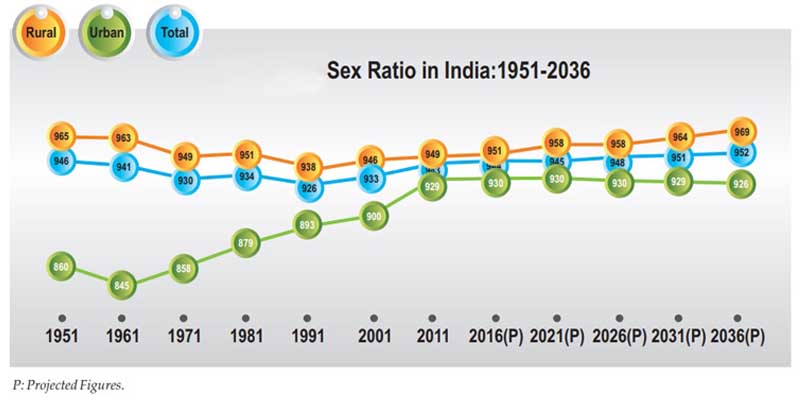- India
- Aug 13
India’s sex ratio to improve to 952 women per 1,000 men by 2036
• The Ministry of Statistics and Programme Implementation (MoSPI) released the 25th issue of its publication titled ‘Women and Men in India 2023’.
• According to the report, sex ratio in India is expected to improve to 952 women per 1,000 men by 2036 from 943 in 2011.
• The report highlights that India’s population in 2036 is expected to be more feminine compared to the 2011 population, highlighting a positive trend in gender equality.
• By 2036, the population of India is expected to reach 152.2 crore, with a slightly improved female percentage of 48.8 per cent compared to 48.5 per cent in 2011.
Significance of the report
• The publication ‘Women and Men in India’ has been released by MoSPI since 1995 is a collection of a variety of gender-related statistics released by different agencies of the government of India.
• The publication is prepared with the objective to provide a variety of available gender statistics at one place to serve as a single platform for accessing gender statistics.
• By providing comprehensive data, this publication contributes to informed policy formulation and fosters progress toward gender equity.
• Strengthening statistical capacities and disaggregating data are crucial commitments toward achieving the 2030 Agenda.
• ‘Women and Men in India 2023’ not only highlights the progress made towards gender equality but also identifies the areas where significant gaps remain.
• The report is a crucial resource for understanding the demographic changes and their implications for both women and men in India. It serves as a vital tool for advocacy and action to promote gender equity and ensure that development efforts are inclusive and sustainable.
Population demographics and dynamics
• A nation’s development is intricately linked to its population demographics and dynamics, guided by development policies. Understanding the interplay between gender and population is vital for shaping environmental, sociopolitical, and economic aspects.
• According to the 2011 Census, India’s population stood at 121.1 crore, with 48.5 per cent being female. By 2036, it is expected to reach 152.2 crore, with a slightly improved female percentage of 48.8 per cent.
• The proportion of individuals under 15 years is projected to decrease from 2011 to 2036, likely due to declining fertility. Conversely, the proportion of the population aged 60 years and above is anticipated to substantially increase during this period.
• Considering the evolving age composition, India’s working-age population is projected to rise until 2036.
• The Report of the Technical Group on Population Projections for India and States 2011-2036 indicates that in 2011, 60.7 per cent of India’s population fell within the working age range of 15-59 years. This percentage is expected to increase to 64.9 per cent by the year 2036.
Age-Specific Fertility Rate
• Age-Specific Fertility Rate (ASFR) is defined as the number of live births in a specific age group of women per thousand female populations of that age group.
• Age Specific Fertility Rate (ASFR) is useful in understanding the age pattern of fertility. It is evident that from 2016 to 2020, ASFR in the age group of 20-24 and 25-29 has reduced from 135.4 and 166.0 to 113.6 and 139.6 respectively which may probably be because of the awareness of economic independence by attaining proper education and securing a job.
• If this is the case, it can be treated as a symbol of breaking the barriers created by the society around women on the misconception of “early marriage and have children”.
• The ASFR in the age group of 15-19 years was 33.9 for illiterate population whereas 11.0 for the literate in 2020. This rate, obviously, is zero for graduates and above and considerably lower for even those who are literate but without any formal education (20.0) as compared to illiterate women re-emphasising the importance of imparting education to women.
Maternal Mortality Ratio
• Maternal mortality in a region is a measure of the reproductive health of women in the area. Many women in reproductive age-span die due to complications during and following pregnancy and childbirth or abortion.
• Maternal mortality is considered as a key health indicator and the direct causes of maternal deaths are well known and largely preventable and treatable. Maternal mortality has been an issue of concern in India for many years, and one of the country’s endless endeavours has been to improve maternal health and bring down the Maternal Mortality Ratio.
• Maternal Mortality Ratio (MMR) refers to the number of women who die as a result of complications of pregnancy or childbearing in a given year per 100,000 live births in that year.
• MMR is one of the SDG indicators and to bring it down to 70 by 2030 is explicitly laid down in SDG framework.
• Owing to ceaseless efforts by the government, India has successfully achieved the major milestone of bringing down its MMR (97/lakh live births in 2018-20), well in time and it should be possible to achieve the SDG target as well. The rate is already below 70 in eight states.
Infant Mortality Rate
• Infant Mortality Rate has been decreasing over the years for both male and female. Female IMR had always been higher than that of male but in 2020, both were equal at the level of 28 infants per 1000 live births. As per Sample Registration System, 2020, Kerala has the lowest IMR of 6 infants per 1,000 live births whereas Madhya Pradesh has the highest IMR of 43.
Under 5 Mortality Rate
• The Under 5 Mortality Rate (U5MR) is a key output indicator for child health and well-being. This is a closely watched public health indicator because it reflects the access of children and communities to basic health interventions such as vaccination, newborn health care facilities, medical treatment of infectious diseases and adequate nutrition.
• The U5MR data shows that it has decreased from 43 in 2015 to 32 in 2020. So is the case for both boys and girls and the gap between boys and girls has also reduced.
• Because of the interventions made by the governments through various programmes and policies, the U5MR had been reduced in the past and the effects of the programs will be reflected in the data in future as well.
Manorama Yearbook app is now available on Google Play Store and iOS App Store


